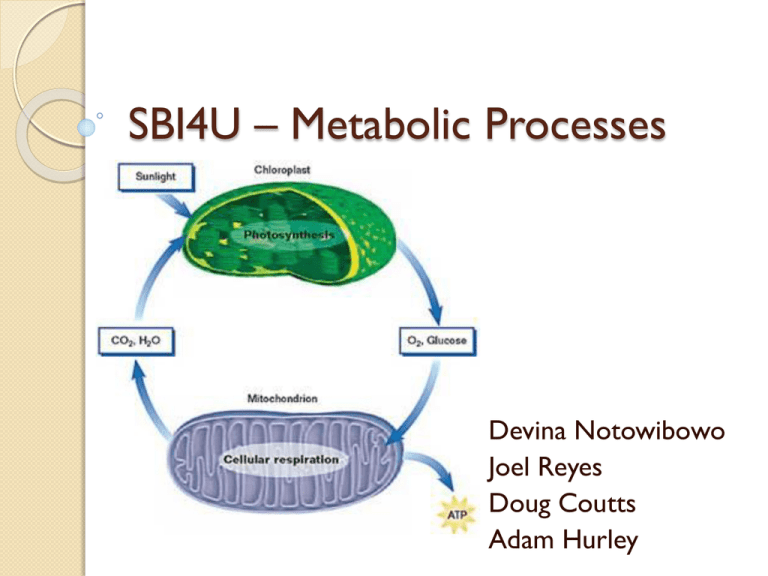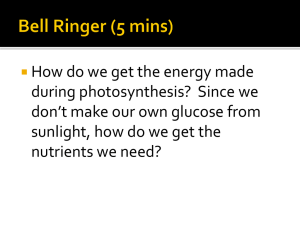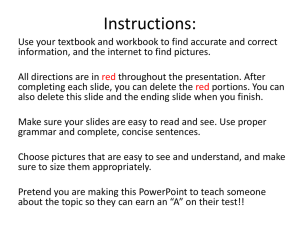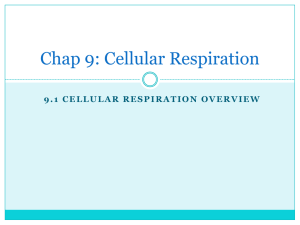SBI4U Metabolic Processes: Cellular Respiration & Photosynthesis
advertisement

SBI4U – Metabolic Processes Devina Notowibowo Joel Reyes Doug Coutts Adam Hurley Essential Question Overall Expectations C1. Analyze the role of metabolic processes in the functioning of biotic and abiotic systems, and evaluate the importance of an understanding of these processes and related technologies to personal choices made in everyday life C2. Investigate the products of metabolic processes such as cellular respiration and photosynthesis C3. Demonstrate an understanding of the chemical changes and energy conversions that occur in metabolic processes. Essential Question Big Ideas 1. All metabolic processes involve chemical and energy changes How and why do plants and animals obtain energy in different ways? 2. Understanding metabolic processes allow people to make informed decisions with respect to personal, societal and environmental factors Guiding Questions 1. What is the common energy molecule across all metabolic processes and how is it made? 2. How are the reactants and products of cellular respiration related to those of photosynthesis 3. What specific organelles are involved and how do their structures contribute to metabolic processes? Unit Plan Monday Tuesday Wednesday Thursday Friday Day 1 Review of Macromolecules Day 2 Introduction to cellular respiration (possible reactants, products, reactions) Day 3 Glycolysis Day 4 Anaerobic vs. aerobic, alcohol fermentation, pyruvate oxidation Day 5 Krebs cycle Day 8 Wet Lab Yeast Fermentation Day 9 Quiz on cellular respiration, introduction of photosynthesis Day 10 Chloroplast Structure and Function Day 6 ETC and oxidative phosphorylation Day 7 Recap of cellular respiration and thermodynamic Day 11 Light Reactions Day 12 Review of light properties, wavelengths, chlorophylls, photosystems, absorption Day 13 Dark Reactions Day 14 Cyclic and noncyclic phosphorylation Day 15 Comparison between photosynthesis and cellular respiration Day 16 In class assignment on photosynthesis Day 17 STSE Day 18 Unit Test: Cellular Respiration/ Photosynthesis Next Unit Next Unit Major Concepts Photosynthesis is a process whereby light energy is used to convert carbon dioxide and water into glucose and oxygen ◦ Light reactions convert energy light into chemical energy in the thylakoids of chloroplasts Chlorophyll molecules are hit by photons and an excited electron is lost (electrons are replaced by the oxidation of water) Excited electrons move through a chain eventually producing ATP and NADPH ◦ Dark reactions use the ATP and NADPH to convert CO2 into glucose in the Calvin cycle Rubisco (enzyme) “fixes” CO2 from the atmosphere into organic carbon Cellular Respiration Cellular respiration is a metabolic process whereby glucose is converted to carbon dioxide and water, and the energy is released in the form of ATP production. Glycolysis which breaks glucose into pyruvate, Pyruvate Oxidation: pyruvate is then converted into acetyl CoA Krebs Cycle: Acetyl CoA is fully oxidized to CO2 ◦ Electron carriers called NADH and FADH2 are produced from the previous stages to feed electrons in the electron transport chain Electron Transport Chain: The electrons pass through the chain and pump protons to form an electrochemical gradient, the electrons eventually reduce oxygen into water Chemiosmosis and Oxidative Phosphorylation: The energy from the proton gradient drives catalytic reaction of ADP and Pi to make ATP Misconceptions Plant light reactions occur in the light, dark reactions occur in the dark ◦ Light reactions are light DEPENDENT ◦ Dark reactions are light INDEPENDENT Only plants perform photosynthesis, and animals perform cellular respiration ◦ Plants, algae, and cyanobacteria can photosynthesize ◦ ALL organisms perform cellular respiration ALL biomass comes from CO2 Connections to other Units Biochemistry – Biochemistry has the fundamental concepts needed to understand metabolic processes (macromolecules, enzymes, organelles) Molecular Genetics – genes code for proteins which can become enzymes, structural proteins, for metabolic processes Homeostasis – homeostasis up/downregulates metabolic processes Population dynamics – not much..











